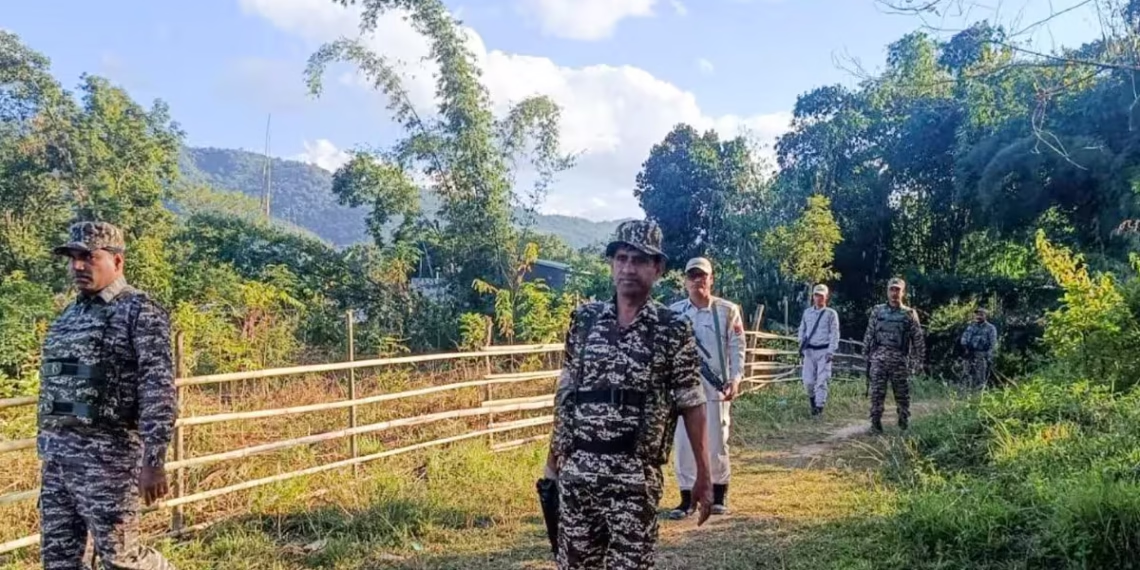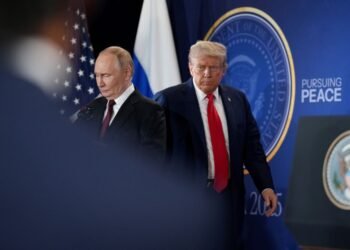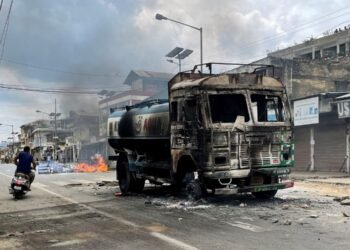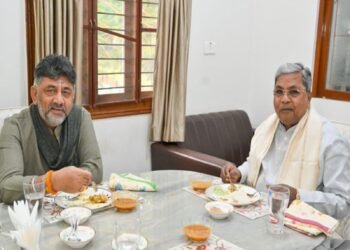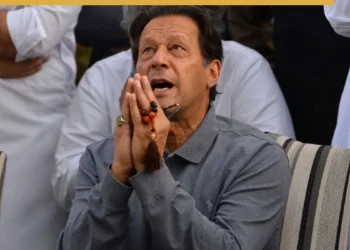Restrictions under Section 163 of the BNSS in Churachandpur, Manipur, underscore the simmering rivalry between the Zomi and Hmar tribes, ignited by a flag dispute. As violence flares within the Kuki-Zo fold, the state faces yet another wave of ethnic unrest, jeopardizing its fragile stability.
BY Navin Upadhyay
Curfew Imposed in Churachandpur, Manipur: Zomi-Hmar Clashes Expose Deepening Intra-Tribe Rivalries
On April 9, 2025, the administration imposed curbs under section 163 of the BNSS in parts of Churachandpur district in Manipur, following escalating tensions between the Zomi and Hmar tribes. The immediate trigger was a dispute over the hoisting of community flags in a “disputed area” between two villages inhabited by these tribes, according to official notifications. This latest flare-up adds another layer of complexity to Manipur’s already volatile ethnic landscape, where intra-tribe rivalries and inter-tribal conflicts, such as the ongoing bloody feud between the Kuki and Naga tribes in Lilong village over a land dispute, continue to undermine peace. This article traces the Zomi-Hmar rivalry, examines previous clashes, and explores how these intra-tribe and inter-tribal tensions are unraveling the fragile social fabric of Manipur.
The Latest Clash: Zomi vs. Hmar in Churachandpur
The imposition of curfew in Churachandpur came as a precautionary measure after tensions boiled over between the Zomi and Hmar communities, both of whom belong to the broader Kuki-Zo ethnic group. Reports indicate that the conflict erupted over a seemingly symbolic act—the hoisting of community flags in a contested area. However, beneath this surface-level disagreement lies a deeper history of mistrust, territorial assertions, and intra-tribal competition. The district administration acted swiftly, enforcing restrictions under Section 163 of the Bharatiya Nagarik Suraksha Sanhita (BNSS) to prevent further violence, a move reminiscent of earlier curfews in the region.
ALSO READ: Kuki-Zo Rejoice Over President Murmu’s Saipikhup in Vienna
This is not the first time Churachandpur has witnessed Zomi-Hmar clashes. In March 2025, violent confrontations between the two tribes left one person dead and several injured. The spark then was an assault on Richard Hmar, the general secretary of Hmar Inpui, by unidentified Zomi individuals following a road rage incident. What began as a personal altercation escalated into communal violence, with mobs engaging in stone-pelting, vandalism, and even gunfire. Despite a peace settlement reached between the apex bodies of the two communities—Hmar Inpui and Zomi Council—the truce proved short-lived, as fresh clashes broke out hours later over the removal of a Zomi militant outfit’s flag. The Zomi Students’ Federation responded by imposing a shutdown, paralyzing normal life in the district.
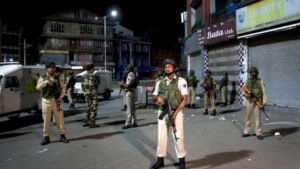
These recurring incidents highlight a fragile coexistence marred by unresolved grievances. The March clashes saw security forces struggling to contain mobs, with tear gas and aerial firing deployed to disperse crowds. The latest curfew in April 2025 underscores the persistent volatility, as authorities brace for potential escalation over what might appear to outsiders as minor provocations but carry deep symbolic weight for the communities involved.
Historical Context: Zomi-Hmar Rivalry
The Zomi and Hmar tribes, while sharing linguistic and cultural ties as part of the Kuki-Zo group, have long navigated a relationship marked by rivalry and occasional cooperation. Both communities inhabit the hill districts of Manipur, including Churachandpur, Pherzawl, and parts of Jiribam, where they vie for influence, resources, and territorial control. Historically, their differences have been exacerbated by political representation, access to development funds, and assertions of distinct identities within the broader Kuki-Zo umbrella.
Previous clashes between the Zomi and Hmar tribes have often been triggered by localized disputes that spiral into broader communal conflicts. The March 2025 violence, for instance, was not an isolated event but part of a pattern of mistrust. The assault on Richard Hmar led to shutdowns not only in Churachandpur but also in Hmar-dominated Pherzawl and multi-ethnic Jiribam, signaling the potential for intra-tribal disputes to destabilize wider regions. Earlier incidents, though less documented, point to disagreements over village boundaries, leadership roles in tribal organizations, and differing alignments during Manipur’s broader ethnic strife.
ALSO READ: Masked Gunmen Attack Manipur Children’s Home; No Casualties Reported
This rivalry is further complicated by the presence of militant outfits and student bodies, such as the Zomi Students’ Federation and Hmar Village Volunteers, which amplify local disputes into organized confrontations. The hoisting or removal of flags—symbols of tribal pride and sovereignty—has repeatedly served as a flashpoint, reflecting deeper struggles over legitimacy and dominance within the Kuki-Zo fold.
Kuki-Naga Conflict: A Parallel Bloodbath in Lilong
While the Zomi-Hmar clashes dominate headlines in Churachandpur, another inter-tribal conflict between the Kuki and Naga tribes rages on in Lilong village, located in Thoubal district. This feud, rooted in a land dispute, has turned deadly, with both sides locked in a cycle of reprisals. The Kukis, predominantly Christian hill-dwellers like the Zomi and Hmar, and the Nagas, another major tribal group with a strong presence in Manipur’s hills, have a history of animosity stretching back decades.
The Lilong conflict is emblematic of broader inter-tribal tensions in Manipur, where land ownership remains a contentious issue due to the state’s unique geography—10% fertile Imphal Valley dominated by the Meitei majority, and 90% hilly terrain inhabited by tribes like the Kukis and Nagas. The Kukis accuse the Nagas of encroaching on their ancestral lands, while the Nagas assert historical claims, often backed by their own militant factions. Clashes in Lilong have involved ambushes, arson, and targeted killings, further straining the state’s overstretched security apparatus.
ALSO READ: Kuki-Zo Warn Meitei Against Chinga Kaba Buffer Breach
The Kuki-Naga rivalry traces its roots to the 1990s, when a major ethnic conflict between the two groups displaced over 100,000 people and razed hundreds of villages. The 1992-1997 clashes, sparked by disputes over land and political power, left a lasting scar, with unresolved grievances festering into the present day. The Lilong dispute is a microcosm of this historical enmity, compounded by the proliferation of arms looted during the 2023 Meitei-Kuki violence, which has empowered tribal militias across Manipur.
Intra-Tribe and Inter-Tribal Strife: A Threat to Peace
Manipur’s ethnic mosaic—comprising over 30 distinct groups within a compact 22,327 square kilometers—has long been a tinderbox. The state has been reeling from the Meitei-Kuki violence that erupted in May 2023, claiming over 250 lives and displacing 60,000 people. That conflict, triggered by a court order supporting Meitei demands for Scheduled Tribe (ST) status, pitted the valley-dwelling Meiteis against the hill-based Kuki-Zo tribes, including the Zomi and Hmar. The imposition of President’s Rule in February 2025, following Chief Minister N. Biren Singh’s resignation, reflects the central government’s struggle to restore order.
However, the Zomi-Hmar clashes and the Kuki-Naga feud reveal a troubling trend: even as the Meitei-Kuki conflict simmers, intra-tribal and inter-tribal rivalries within the hill communities are fracturing what little unity remains. The Kuki-Zo group, despite presenting a united front against the Meiteis, is internally divided, with the Zomi, Hmar, and Thadou (another Kuki sub-tribe asserting a distinct identity) pulling in different directions. Similarly, the Nagas, while historically at odds with the Kukis, face their own internal fissures.
These rivalries undermine peace efforts at multiple levels. Joint peace committees, such as the one proposed after the March 2025 Zomi-Hmar clashes, struggle to hold amid recurring violence. The Central government’s recent meeting with Meitei and Kuki representatives on April 5, 2025, aimed at reconciliation, has yet to address these intra-tribal dynamics. Meanwhile, the proliferation of looted weapons—over 3,000 firearms stolen in 2023—has turned local disputes into armed confrontations, making mediation harder.
Impact on Manipur’s Peace
The cumulative effect of these conflicts is a state teetering on the edge of anarchy. Churachandpur, once a symbol of Kuki-Zo resilience, is now a hotspot of intra-tribal strife, with curfews and shutdowns disrupting daily life. Lilong’s land dispute threatens to reignite a full-scale Kuki-Naga war, echoing the devastation of the 1990s. The broader Meitei-Kuki violence, though relatively quieter since late 2024, remains unresolved, with militias on both sides entrenched along ethnic fault lines.
The social and economic toll is staggering. Educational institutions, markets, and roads—the lifelines of any community—remain shut during flare-ups, as seen in Churachandpur’s repeated shutdowns. Displacement camps, housing thousands from the 2023 violence, are a stark reminder of the human cost. Trust in security forces and the government is eroding, with locals accusing authorities of bias or inaction.
Manipur’s strategic location, bordering Myanmar, adds a regional dimension. The central government’s plan to fence the porous border and suspend the Free Movement Regime—a response to alleged Kuki migration from Myanmar—has further alienated hill tribes, fueling their sense of marginalization. If intra-tribal and inter-tribal conflicts persist, they risk destabilizing not just Manipur but the broader Northeast, a region with a history of insurgency and ethnic unrest.
ALSO READ: Manipur: A Month After Shah’s Mobility Pledge, Defiant Tribals Stall Any Breakthrough
The curfew in Churachandpur on April 9, 2025, is more than a response to a flag dispute; it is a symptom of deep-seated rivalries between the Zomi and Hmar tribes, compounded by the Kuki-Naga bloodshed in Lilong and the lingering Meitei-Kuki conflict. These intra-tribe and inter-tribal tensions reveal a state fractured by identity, land, and power struggles. Peace in Manipur demands more than curfews or security deployments—it requires dialogue that addresses historical grievances, equitable resource distribution, and a dismantling of the armed militancy that sustains these cycles of violence. Without such efforts, the state’s diverse communities risk being trapped in a perpetual spiral of distrust and retribution, far from the unity they once aspired to achieve.


